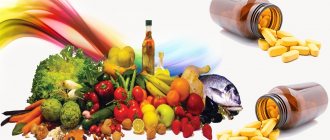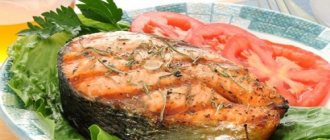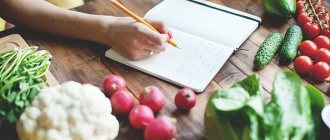During vomiting, the body loses many nutrients that need to be replenished through diet.
A diet after vomiting allows you to restore the water-salt balance, improve digestion and eliminate inflammation of the gastrointestinal tract (GIT).
First steps after severe vomiting
If an unpleasant symptom occurs, the following measures must be taken:
- Rinse your mouth and clear your nasal passages of vomit. For a small child or unconscious person, the cavities are cleaned with a cotton swab dipped in a warm soda solution (2%).
- Take a sitting position in which there is no pressure on the stomach. If the patient is weakened or unconscious, lay him on his side without placing a pillow under his head.
- Drink in small portions at least once every 1-2 hours. To replenish the balance of electrolytes, use saline solution, Regidron, Asparkam or their analogues.
- If vomiting appears several hours after eating, this may indicate poisoning or food intolerance. To speed up the elimination of toxins, you need to take activated carbon (1 tablet per 10 kg of weight), Enterosgel or Polysorb (according to the instructions). Enterosorbents should be taken at least 2 hours before or after meals.
- Take a break from eating for at least 4-5 hours. In case of exacerbation of pancreatitis, a starvation diet is introduced for 1-2 days. In case of food poisoning, it is recommended to abstain from food for 10-12 hours.
- If vomiting is caused by unknown reasons (for example, toxicosis during pregnancy, a migraine attack, or motion sickness in transport), then it is undesirable to take special medications (Cerucal, Metoclopramide, etc.) without a doctor’s examination. The indication for calling an ambulance is nausea, which is accompanied by severe headache, high fever, the appearance of blood and “coffee grounds”, loss of consciousness, convulsions, abdominal pain and tension in the abdominal wall.
If vomiting is caused by food poisoning, you should start taking Polysorb or other enterosorbents.
If a small child is vomiting, it is recommended to reduce the amount of food consumed by a third, replacing the missing volume with liquid and increasing the frequency of feedings.
The procedure is determined by the nature of the symptom, accompanying signs and medical history.
When treating, you need to take into account the following factors:
- number of episodes (multiple, single);
- the presence of impurities of mucus, bile, blood;
- color of vomit and stool;
- other signs (diarrhea, abdominal pain, headache, photophobia, elevated body temperature, apathy, icteric skin color, etc.).
When treating vomiting, it is important to consider other symptoms, such as abdominal pain.
For example, in case of poisoning and intestinal infection, vomiting is most often accompanied by diarrhea, and in case of inflammation of the gastrointestinal tract - pain in the projection of the affected organ.
Causes of nausea not related to digestive pathologies are blood intoxication, toxicosis of pregnancy, taking certain medications and brain infections. In this case, the vomiting center is irritated, so the effectiveness of detoxicants and diet will be significantly lower than for gastrointestinal diseases.
Food poisoning: is a doctor necessary?
Often food poisoning occurs in a fairly mild form, and most of us do not consider it necessary to visit a doctor, much less call an ambulance. But if the symptoms indicate a severe form of poisoning, medical help can be a matter of life or death. You should definitely visit a doctor if you or a loved one has:
- symptoms of severe dehydration: dizziness, dry mouth, rare and weak urination;
- diarrhea lasting three days or longer;
- blood in stool;
- high body temperature (above 38.5°C).
The presence of at least one of these signs may indicate critical changes in the condition. To return a person to normal, emergency measures may be needed - intravenous fluid administration, the prescription of strong antibiotic medications, etc. In this case, you should immediately go to see a doctor or call an ambulance if the patient’s condition does not allow him to get to the clinic on his own.
Features of nutrition on the first day after vomiting
On the first day after attacks of vomiting, it is recommended to include white bread crackers, biscuits, rice and oatmeal jelly, and herbal decoctions with anti-inflammatory effects in the menu.
Adult patients should completely abstain from other foods in order to restore the intestinal microflora and relieve inflammation of the gastrointestinal mucosa. From the 2nd day, liquid porridges, weak broths, baked apples, bananas, starchy purees and fermented milk products are introduced into the menu. On the 3-4th day, the diet can be diversified with steamed dishes from lean meat and fish, cottage cheese, eggs and other dietary products.
On the second day after vomiting, liquid porridge is introduced into the diet.
During the recovery period of the gastrointestinal tract, it is necessary to eat 7-8 times a day. The serving volume should be 100-150 ml.
If a baby is vomiting, it is recommended to take a break from feeding for 4-6 hours, and then feed only breast milk or formula, excluding any types of complementary foods. On the first day, the volume of food is reduced by 30%, and the break between meals is up to 2 hours. In the absence of repeated vomiting, from the 2nd day the volume of food is gradually increased, and by the 4th day it is brought up to the age norm and complementary foods begin to be introduced.
Children over one year old are recommended to spend a fasting period of 6-12 hours, during which they can only take enterosorbents, children's kefir and weak herbal decoctions. On the 2nd day, the child is given liquid rice porridge, baked apples, crackers, kefir and pureed vegetable soups.
A child over one year old can be given pureed vegetable soup on the second day of treatment.
Products recommended after food poisoning
During the recovery period, you should not burden the stomach and intestinal tract with the digestion of heavy food. It is better to choose foods that are easy to digest, which include:
- boiled rice;
- fresh bananas and apples;
- toast without butter;
- fermented dairy products - yogurt, kefir, yogurt;
- pickled vegetables – cabbage, apples, etc.;
- oatmeal with water;
- mashed potatoes;
- low-fat broth;
- chicken or turkey meat, baked without skin.
It is advisable to adhere to such a diet for two to three days after poisoning, until intestinal function is fully restored.
Drinking regime
The fluid norm for nausea and vomiting is at least 2-2.5 liters per day. The amount of water for a child is calculated in the proportion of 50-60 ml per 1 kg of weight. When breastfeeding or bottle-feeding, children under one year of age are recommended to drink 200 ml of water per day.
After each attack of vomiting or diarrhea, you need to drink 250-300 ml of water. To prevent an exacerbation of the process, this amount can be divided into 2-3 doses. Small children are given additional fluid at the rate of 100-150 ml for each episode of vomiting and 100-200 ml for diarrhea.
Fully or partially limited products
The diet for vomiting in children prohibits the consumption of any pastries and bakery products, concentrated broths and soups based on them, porridges with coarse cereals (millet, barley, barley), cheeses, fatty fermented milk products, cream and sour cream.
Excluded from the diet: fatty red meats and waterfowl meat, fish, solid animal fats, sausages, canned foods, smoked meats, fast food, processed foods, legumes, marinades, pickles.
The consumption of mushrooms, fresh vegetables, fruits, as well as hot and spicy seasonings and spices, hot sauces, ketchups and mayonnaise, chocolate, and ice cream is not allowed. As for drinks, it is not recommended to consume packaged juices, cola, strong tea and coffee, and carbonated drinks.
Table of prohibited products
| Proteins, g | Fats, g | Carbohydrates, g | Calories, kcal | |
Vegetables and greens | ||||
| spicy vegetables | 2,8 | 0,5 | 5,3 | 36 |
| vegetables legumes | 9,1 | 1,6 | 27,0 | 168 |
| canned vegetables | 1,5 | 0,2 | 5,5 | 30 |
| swede | 1,2 | 0,1 | 7,7 | 37 |
| cabbage | 1,8 | 0,1 | 4,7 | 27 |
| sauerkraut | 1,8 | 0,1 | 4,4 | 19 |
| cauliflower | 2,5 | 0,3 | 5,4 | 30 |
| bulb onions | 1,4 | 0,0 | 10,4 | 41 |
| cucumbers | 0,8 | 0,1 | 2,8 | 15 |
| canned cucumbers | 2,8 | 0,0 | 1,3 | 16 |
| pickles | 0,8 | 0,1 | 1,7 | 11 |
| radish | 1,2 | 0,1 | 3,4 | 19 |
| white radish | 1,4 | 0,0 | 4,1 | 21 |
| turnip | 1,5 | 0,1 | 6,2 | 30 |
| canned tomatoes | 1,1 | 0,1 | 3,5 | 20 |
| garlic | 6,5 | 0,5 | 29,9 | 143 |
Fruits | ||||
| pears | 0,4 | 0,3 | 10,9 | 42 |
Berries | ||||
| grape | 0,6 | 0,2 | 16,8 | 65 |
Mushrooms | ||||
| mushrooms | 3,5 | 2,0 | 2,5 | 30 |
| marinated mushrooms | 2,2 | 0,4 | 0,0 | 20 |
Nuts and dried fruits | ||||
| nuts | 15,0 | 40,0 | 20,0 | 500 |
Cereals and porridges | ||||
| corn grits | 8,3 | 1,2 | 75,0 | 337 |
| pearl barley | 9,3 | 1,1 | 73,7 | 320 |
| Wheat groats | 11,5 | 1,3 | 62,0 | 316 |
| millet cereal | 11,5 | 3,3 | 69,3 | 348 |
| barley grits | 10,4 | 1,3 | 66,3 | 324 |
Flour and pasta | ||||
| pasta | 10,4 | 1,1 | 69,7 | 337 |
Bakery products | ||||
| Old Russian grain bread | 9,6 | 2,7 | 47,1 | 252 |
| Rye bread | 6,6 | 1,2 | 34,2 | 165 |
Confectionery | ||||
| candies | 4,3 | 19,8 | 67,5 | 453 |
| cake | 3,8 | 22,6 | 47,0 | 397 |
Chocolate | ||||
| chocolate | 5,4 | 35,3 | 56,5 | 544 |
Raw materials and seasonings | ||||
| ketchup | 1,8 | 1,0 | 22,2 | 93 |
| mayonnaise | 2,4 | 67,0 | 3,9 | 627 |
| soy sauce | 3,5 | 0,0 | 11,0 | 58 |
| vinegar | 0,0 | 0,0 | 5,0 | 20 |
Dairy | ||||
| milk 4.5% | 3,1 | 4,5 | 4,7 | 72 |
| cream | 2,8 | 20,0 | 3,7 | 205 |
Meat products | ||||
| pork | 16,0 | 21,6 | 0,0 | 259 |
Sausages | ||||
| dry-cured sausage | 24,1 | 38,3 | 1,0 | 455 |
Bird | ||||
| smoked chicken | 27,5 | 8,2 | 0,0 | 184 |
| duck | 16,5 | 61,2 | 0,0 | 346 |
| smoked duck | 19,0 | 28,4 | 0,0 | 337 |
| goose | 16,1 | 33,3 | 0,0 | 364 |
Fish and seafood | ||||
| dried fish | 17,5 | 4,6 | 0,0 | 139 |
| smoked fish | 26,8 | 9,9 | 0,0 | 196 |
| canned fish | 17,5 | 2,0 | 0,0 | 88 |
Oils and fats | ||||
| animal fat | 0,0 | 99,7 | 0,0 | 897 |
| cooking fat | 0,0 | 99,7 | 0,0 | 897 |
Non-alcoholic drinks | ||||
| cola | 0,0 | 0,0 | 10,4 | 42 |
| lemonade | 0,0 | 0,0 | 6,4 | 26 |
| Pepsi | 0,0 | 0,0 | 8,7 | 38 |
| black tea | 20,0 | 5,1 | 6,9 | 152 |
Juices and compotes | ||||
| tomato juice | 1,1 | 0,2 | 3,8 | 21 |
| * data is per 100 g of product | ||||
Foods that stop vomiting
The following products will help overcome nausea and recover from vomiting:
- non-acidic natural yogurt, cottage cheese with a fat content of 1-5%;
- boiled eggs;
- dry toast;
- baked apples without peel;
- boiled carrots;
- rice water, liquid porridge (rice, buckwheat, oatmeal);
- mashed starchy vegetables;
- bananas.
Boiled eggs help restore the gastrointestinal tract after vomiting.
The menu for toxicosis in pregnant women has some nuances, since nausea in this case is caused not by irritation of the gastrointestinal tract, but by stimulation of the vomiting center.
If nausea is caused by an exacerbation of a disease of the digestive system, kidneys or liver, then to alleviate the condition you need to adhere to an appropriate therapeutic diet.
Advantages and disadvantages
| pros | Minuses |
|
|
Meat zrazy stuffed with omelette
For preparation you will need:
- beef tenderloin – 300 g
- stale white bread – 40 g
- milk – 100 ml
- egg – 1 pc.
- salt to taste
- butter – 5 g
First, prepare an omelette: beat the egg with milk, add a little salt. It is better to bake in a dry non-stick frying pan over medium heat with a lid. If you don’t have such utensils, you can lightly grease the bottom of the pan with melted butter. The finished omelette should be cooled and chopped into small pieces.
Soak white bread in milk, squeeze. Pass the meat with the soaked bread through a meat grinder twice - the smaller the pieces of beef, the more homogenized the consistency of the minced meat, the better. Add salt and mix well.
Form the minced meat into flat cakes, place an omelette in the middle as a filling, carefully pinch the edges of the flat cake. Steam meat zrazy stuffed with omelette (in a double boiler, slow cooker, or in a saucepan with a lid, using special inserts for steaming). Cooking time – 40 minutes.
Medical nutrition, recipes
If you have intestinal disorders, you should avoid spicy, fried, fatty foods, fast food, processed meat products, canned food, as well as sweet carbonated drinks and commercial juices. The basis of the diet should be steamed or boiled dishes. In this case, the emphasis should be on high-protein foods with a rich vitamin and mineral composition.
The basic principles of a diet for gastrointestinal disorders are frequent split meals at least 5 times a day, gentle cooking methods and the use of products that help normalize the functioning of the gastrointestinal tract. We have prepared several useful recipes.
Rice soup with blueberry infusion
The traditional “old-fashioned” recipe for diarrhea and vomiting – rice porridge for breakfast, lunch and dinner – is not the best advice. This food is too heavy if you have problems with the gastrointestinal tract. It's a matter of rice water! You can drink it to prevent dehydration. But you can also prepare dishes that are useful for gastrointestinal disorders using rice water.
To prepare 1 serving you will need:
- long grain rice – 30 g
- dried blueberries – 40 g
- water – 750 ml
- sugar – 1 tsp.
- lemon juice – 1 tbsp.
- white bread – 100 g
Wash the rice before cooking. Boil in 400 ml of water until tender and rub through a fine sieve along with the remaining broth. Boil pre-washed dried blueberries in the remaining 350 ml of water, leave in the pan, without draining the water, to steep for 30 minutes. Then the blueberry infusion should be strained through a fine sieve or clean gauze folded in several layers, add grated rice, sugar and lemon juice to the resulting liquid.
Dry the diced white bread in a frying pan without adding oil. Serve croutons with soup.
note
It is not advisable to replace dried blueberries with fresh or frozen ones in a recipe. While this berry is certainly healthy and has long been used as a proven folk remedy for stomach problems, the effect of blueberries on various gastrointestinal disorders directly depends on the form in which it is used. Fresh berries cope well with gastrointestinal disorders caused by constipation. But dried, on the contrary, helps with diarrhea.
Photos are for illustrative purposes only. From open sources.
Causes of vomiting in children
A pathological reaction occurs due to reasons such as:
Possible causes of vomiting in a child.
- poisoning by low-quality food, medicines, chemicals, gases;
- exposure to intestinal infection;
- reaction to an unusual or exotic dish;
- feeding a child against his will;
- damage to the body by helminths;
- metabolic disorders due to diabetes;
- damage to the lining of the stomach due to gastritis, ulcers, dyskinesia of the bile ducts, cholecystitis, gastroduodenitis, cholecystitis, gastroenteritis;
- appendicitis, intestinal obstruction due to the penetration of one part of it into another (pathology requiring urgent surgical intervention);
- GERD (gastroesophageal reflux disease);
- meningitis, encephalitis, a sharp rise in temperature with influenza and sore throat;
- brain injury, migraine;
- pathologies of the central nervous system;
- heart or kidney failure;
- heat, sunstroke.
The most common causes are poisoning, ingestion of unusual food, infection with worms or infection. In kindergartens, the spread of rotavirus infection is sometimes recorded. Children under 2 years of age can swallow household chemicals and other inedible substances and small objects. You need to carefully monitor them without losing sight of them.
GERD is sometimes observed in children under 1 year of age.
Reviews and results
A diet for vomiting in children is an essential component of complex treatment and, according to parents’ reviews, contributes to the rapid recovery of the body after vomiting and a speedy recovery of the child.
- “... Almost all the children in the pioneer camp and our child also got poisoned by eating sweet curds for dessert. The child began vomiting, and later developed diarrhea and low-grade fever. Later weakness, headache, dizziness appeared. The ambulance diagnosed a foodborne illness. The child's stomach was washed and he was given several enterosorbent tablets. It is recommended to drink a lot of fluids, including saline solutions, as well as diet foods excluding sweets, meat, and raw vegetables/fruits. After 4 days he felt better, and we gradually began to expand his diet.”











